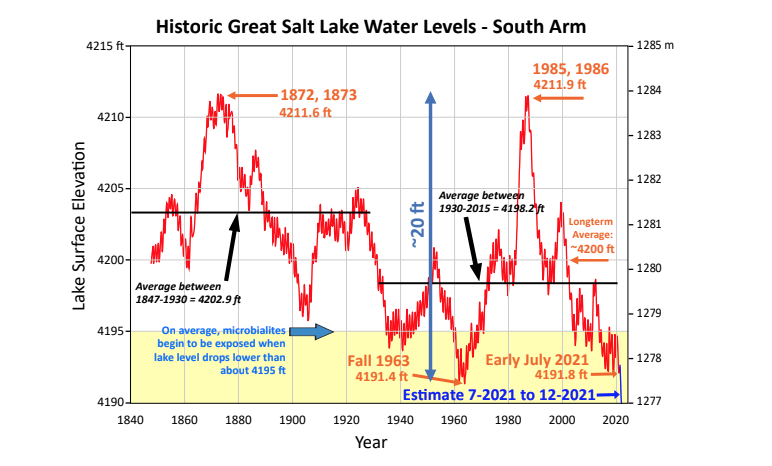Media Inquiry:
Hollie Brown 801-243-9466
Mark Milligan 801-949-1611

Drought Negatively Impacting Great Salt Lake Microbialites and Ecosystem

Aerial image of Great Salt Lake (from 2016) showing the approximate extent of microbialites in relation to lake floor elevation (bathymetry).
Salt Lake City (July 15th, 2021) – As Utah’s drought continues to impact Great Salt Lake water levels, scientists from the Utah Geological Survey (UGS) are concerned about the long-term implications to microbialites, underwater reef-like rock mounds created by millions of microbes. These structures and their microbial mats form the base of the entire Great Salt Lake ecosystem, serving as a primary food source for brine shrimp and brine flies.
“We think of these structures as living rocks,” stated Michael Vanden Berg, UGS Energy and Minerals Program Manager. “They accumulate as the result of microbe communities trapping and binding sediment and/or triggering calcium carbonate minerals to precipitate from the water column. The population in Great Salt Lake is one of the largest accumulations of modern microbialites in the world.”
Similar to plants, the microbes use photosynthesis to grow and bring the sun’s energy into the lake. “Our studies show the whole lake system, including the ten million migrating birds, depend on microbialites,” said Dr. Bonnie Baxter, director of the Great Salt Lake Institute at Westminster College. “Without these critical structures, impacts will be amplified up the food chain.”

Microbialites in Bridger Bay, northern Antelope Island, populate elevations between about 4190 and 4195 ft, with the densest accumulation at about 4192 to 4193 ft. This photograph was taken on July 1, 2021, when lake elevation was at 4191.8 ft, showing the deepest population of microbialites in the bay, which were covered with only about one foot of water. Lake levels are projected to drop even farther this coming fall, exposing nearly the entire population of microbialites in Bridger Bay.
The majority of Great Salt Lake microbialites span an elevation of approximately 4185 to 4195 feet, with some as low as about 4180 feet. Lake level is projected to drop below the historic low of 4191.4 feet (recorded in fall 1963) in the next few days and will continue to drop well into the fall. Historic low lake levels in the coming months will expose a very significant proportion of microbialites, creating a situation that has never been observed. More locally, in Bridger Bay on the northern end of Antelope Island, the entire microbialite population could be exposed.
“We have seen from previous studies that it only takes a short period of exposure time, maybe weeks, for the microbial mat to “die” and erode off the top of the microbialite structures,” stated Vanden Berg. “It takes several years of higher lake level before the microbial mat can recover. The exposure this fall may have lasting, unpredictable consequences for the microbialite population for years to come, even if lake levels return to higher levels in subsequent years.”
For more information on microbialites, visit https://geology.utah.gov/resources/energy/oil-gas/#tab-id-3





